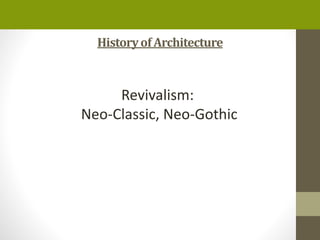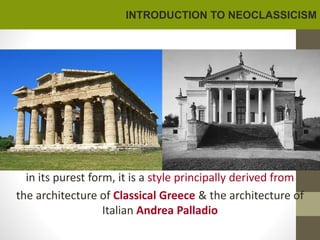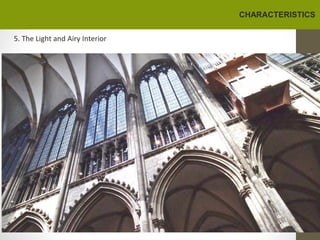History of Architecture.pdf
- 1. HistoryofArchitecture Revivalism: Neo‐Classic, Neo‐Gothic Padmashree Dr D Y Patil College of Architecture, Akurdi, Pune 44.
- 2. Revivalism Revivalism in architecture is the use of visual styles that consciously echo the style of a previous architectural era. INTRODUCTION TO REVIVALISM
- 3. INTRODUCTION TO NEOCLASSICISM in its purest form, it is a style principally derived from the architecture of Classical Greece & the architecture of Italian Andrea Palladio
- 4. INTRODUCTION TO NEOCLASSICISM intellectually Neoclassicism was characteristic of a desire to return to the perceived "purity" of the arts of Rome, the more vague perception ("ideal") of Ancient Greek arts and, to a lesser extent, sixteenth-century Renaissance Classicism
- 5. CHARACTERISTICS symmetrical shape tall columns that rise the full height of the building triangular pediment domed roof
- 6. CHARACTERISTICS obsessed with straight lines, archaeological motifs & idealized vision of nature
- 8. Major structure built in this Period Palace of Versailles, France Pantheon, Paris
- 9. Rotunda at the University of Virginia Roman Pantheon
- 11. Monticello – Jefferson’s residence Drayton Hall, Carolina
- 13. The Seven Key Characteristics of Gothic Architecture 1. Grand, Tall Designs, Which Swept Upwards With Height and Grandeur The magnificent gothic exterior of York Minster in the UK 2. The Flying Buttress St Vitus Cathedral in Prague Castle
- 14. Characteristics: 3. The Pointed Arch The delicate vaulted ceilings of Malbork Castle in Poland CHARACTERISTICS
- 15. 5. The Light and Airy Interior CHARACTERISTICS
- 16. 6. The Gargoyles of Gothic Architecture 7. The Emphasis Upon the Decorative Style and the Ornate CHARACTERISTICS
- 17. Gothic Revival was a Victorian style inspired by Gothic cathedrals and other medieval architecture. In the early twentieth century, Gothic Revival ideas were applied to modern skyscrapers. Twentieth Century Gothic Revival buildings are often called Neo-Gothic. Neo- Gothic/ Gothic Revival
- 18. Strong vertical lines and a sense of great height Pointed windows with decorative tracery Gargoyles and other carving Pinnacles FEATURES
- 19. FEATURES
- 20. • Built in 1924. • The architects - Raymond Hood and John Howells • Their Neo-Gothic design may have appealed to the judges because it reflected a conservative (some critics said "regressive") approach. • The facade of the Tribune Tower is studded with rocks collected from great buildings around the world. MAJOR STRUCTURE BUILT IN THIS PERIOD The Chicago Tribune Tower
- 21. Victorian Gothic Revival Between 1855 and 1885, John Ruskin and other critics and philosophers stirred interest in recreating a more authentic Gothic architecture, like buildings from centuries before. The 19th century buildings, called High Gothic Revival, High Victorian Gothic, or Neo-Gothic, were closely modeled after the great architecture of medieval Europe.
- 22. Perhaps the most famous example of High Victorian Gothic architecture is Victoria Tower (1860) at the royal Palace of Westminster in London, England. A fire destroyed most of the original palace in 1834. After lengthy debate, it was decided that architects Sir Charles Barry and A.W. Pugin would rebuild Westminster Palace in a High Gothic Revival style that imitated 15th century Perpendicular Gothic styling. Victoria Tower is named after the reigning Queen Victoria, who took delight in this new Gothic vision.
- 24. Masonry construction Patterned brick and multi-colored stone Stone carvings of leaves, birds, and gargoyles Strong vertical lines and a sense of great height Realistic recreation of authentic medieval styles FEATURES


























